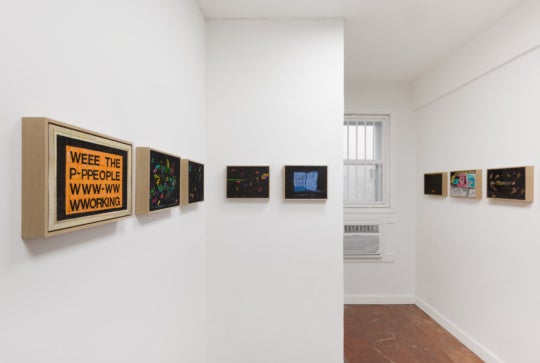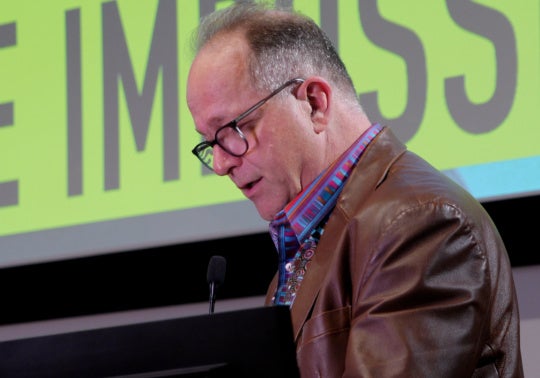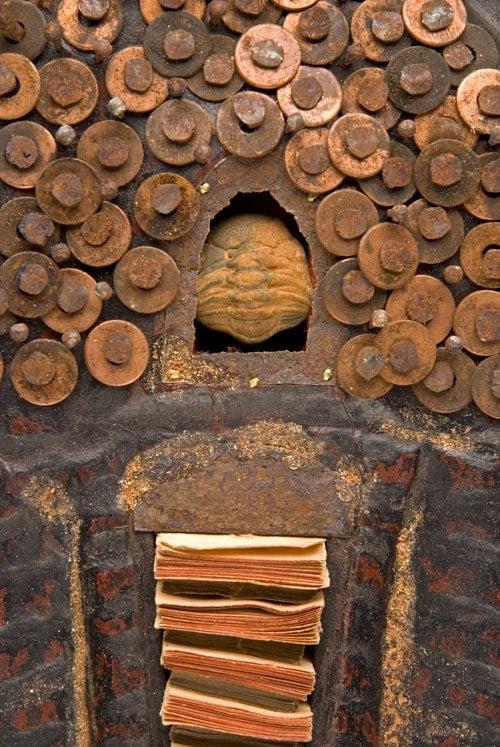Lyle Ashton Harris has spent the last seven years living in both Accra, Ghana and New York City, creating and teaching on both respective New York University campus locations. Through his observations and experiences in both cities, Harris is able to explore and share not only the history but also the modern-day settings of such separate cultures.
Accra My Love, Lyle Ashton Harris’s exhibition at the Fine Arts Gallery at Kennesaw State University, showcases historical and contemporary imagery from Ghana through blown up collages and the incorporation of past works such as The Jamestown Prison Erasure series and Untitled (Black Power) [March 14-April 24, 2013]. Through images of historical figures, landscapes, and references to popular culture, Harris documents the history and current state of Ghanaian culture. The relationships between the images allow a necessary dialogue not only on inevitable globalization, but also on the specific histories and traditions behind some of the images and how they allow for multiple interpretations. Harris and I met in person during his visit to Atlanta to discuss how his time spent in Ghana influences his works and how both contemporary and traditional aspects of the culture function together.

Claire Maxwell: First, let’s talk about the KSU exhibition, Accra My Love. You simultaneously examine history as well as contemporary experiences, mostly through collage. Is that right?
Lyle Ashton Harris: A main part of this exhibition is the installation that was in Accra My Love II. The first iteration was for a 20-year survey exhibition at the Scottsdale Museum of Contemporary Art [Scottsdale, AZ] in 2008. But a lot of the work was drawn from a show I did at CRG in 2010 called Ghana. In that exhibition, I premiered the Jamestown Prison collages as well as the Untitled (Black Power) piece, which takes its title from Richard Wright’s seminal, global, controversial book Black Power.
CM: You split your time equally between New York and Ghana?
LH: Yes. For the last seven years, I’ve been spending several months in Ghana each year teaching at NYU’s global Accra campus as well as maintaining a studio there.
CM: How do you bring back and compare your experiences in Ghana to those in New York City?
LH: I recently returned to New York, and I’ll be here for the next couple of years to reorient myself back into New York. This exhibition—which was commissioned by the Zuckerman Museum—is a confluence of a multiplicity of things. I would definitely say it suggests the tension of occupying both spaces, both locations, with the shared histories—the dimensions of tradition and how one may rub up against the other, including the force that’s actually occupying both spaces.
CM: How does your creative process work and how do you feel it’s changed over the years, if at all?
LH: For the last twenty years, I’ve been exploring various types of photographic practices. As far as photographic practices, I have done a range of studio-based portraiture, self-portraiture, and some editorial work for some publications such as New York Times Magazine. And I was known for several bodies of work in which issues of race, sexuality, and gender were represented. The shift in my practice came around 2004 when a fellow artist, Jim Hodges, came in my studio soon before I was about to travel for this exhibition in Chicago, and he could see I was struggling in trying to take some of the energy that was happening in the studio and the collages on the wall and actually bring the energy outside of the studio. (Because I would do collages in the studio just by nature or thought process.) On occasion they would be photographed and made into a montage like The Watering Hole series from 1996 or Memoirs of Hadrian from 2002, but what was distinctive about this particular shift in 2004 is that I took the actual collages that were being made in the studio and brought all that material into an art context.
It’s interesting to me what has happened between 2008 and 2013 with Accra My Love—the first iteration and now, the one commissioned at the Zuckerman Museum. What I like about this opportunity is that I’m able to revisit some of those themes that were initially addressed or suggested in Accra My Love I and really to wrestle with what has happened since then. For example, in this particular iteration, there is an element of melancholy, images from the funeral of my partner’s father, as well as multiple references to Ghanaian funerary practices, and my own personal loss and grief associated with my return to the U.S. This is the first installation that I’ve altered the funerary fabric by cutting, inserting this pattern onto the wall.
CM: Let’s talk about Blow Up. How do you feel like the current Accra My Love draws from that and any of the themes? A lot of imagery references gender assumptions and ethnicity.
LH: What I find fascinating about that question in relationship to collage is that out of the hundreds of images in Accra My Love II, the majority are sourced from Ghana—acquired either from or while I was in Ghana. It is a culture that has a deep respect for tradition, imagery that alludes to this in Accra My Love II include funerary practices and a reverence for family… simultaneously rubbing up against modernity and a culture in transition. There are images in Accra My Love II that are clearly sourced from Ghana, i.e. newsprints, but there are also images that might suggest a western influence–let’s say same-sex desire, for example– that are also sourced from Ghana and speak to the complexity of this dialogue.
CM: Do find larger scale collages carry more audience impact than individual stand-alone photographs or portraits?
LH: I think both are of interest. I think it depends on the audience. I think what happens in the context of a collage such as this, is the use of the mirrors—the mirroring incorporates and engages the viewer in mise-en-scéne. I think the collage opens up possibilities. But, with that said, I do believe in the power of the images to be able to be a distilled exploration of family, etc.
CM: I’m glad to see older works included in the exhibition at Kennesaw. Were you planning on including these older works like the ones from Jamestown Prison Erasure series and Untitled (Black Power)?
LH: Absolutely. This particular installation right here—it was essential that we have those even though the [collage] dominates. There’s something quite alive about it.
CM: How do you utilize your teaching experiences in Ghana, as well as in New York City, in your practice? Do you feel like the NYU program in Ghana is beneficial for students?
LH: I think it’s an amazing thing for students to be able to have the opportunity to travel. I think most of the students I teach would have traveled abroad in high school—most likely Europe, on occasion Asia, and on occasion Latin America. But Africa…very few, in my experience, have traveled there. It’s a wonderful opportunity to be involved and able to share knowledge. In this situation I’m able to grow on my knowledge and be able to share that and to challenge. As far as my own work is concerned, I love teaching because it keeps me young and keeps me on my toes.
CM: I really enjoy coming in and being immersed with all these images that I’m not typically exposed to.
LH: Anything that you would experience here in terms of ideas of class, ethnicity, or culture is actually embodied in this particular collage itself. For example, the [magazine page] that says ‘Special Help: The City Beckons.’ The [BBC] has a series of contemporary magazines exploring Africa. Now, when they say ‘the city beckons’ they’re talking about the new cosmopolitism. So in this particular collage I’m actually injecting the fact that the idea of gender difference is part of ‘the city beckons.’ In a certain sense, it’s giving elasticity or expanding what that particular title might actually suggest. In a way, it’s allowing the imagery and the text to work in a dialogic relationship with each other.
CM: Do you have any other projects or collaborations going on right now?
LH: Right now I’m back in the studio with a couple of books I’d like to work on as well.
CM: Do you think it’s important that art has varying levels of accessibility?
LH: I remember when I showed Blow Up in Seville [Spain], it was amazing what people who were there could identify because it was material that they found pleasurable and interesting. And one of the important gifts is that people can have multiple entry points.
Accra My Love is on view at the Fine Arts Gallery at Kennesaw State University through April 24.




